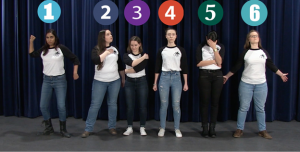12 Who Would You Like to Work With?
Description:
In Who Would You Like to Work With?, six different statues are presented to the audience. This introductory activity begins to ask important questions about what initial assumptions we might make about people without even realizing it.
Topic Risk Level: Low
Dramatic Skill Difficulty: Low
Watch the Scene:
Facilitation & Jokering
Voting with your feet:
- In this scene, we ask learners: “If you were to do a group project, based solely on what you can see of these statues, who would you most want in your group?” We then ask them to ‘vote’ by either going to an area of the room that represents one of the statues or by raising hands. This is the first step in understanding what underlying assumptions one might make that impact their decision making. Once they have voted, you can ask co-learners to reflect on what was going on internally as they made their decisions.
- After a first discussion, choose one of the statues. It can be interesting to choose a statue one that received very few or no votes. Invite learners to come up with words that they might associate with that statue. Through this process we can deepen the discussion around underlying assumptions. We have found that learners are very surprised to hear that others in their group or class have interpreted the statue very differently than they did.
Initiating Questions
- What was your decision-making process in picking the statue you chose? (A possible prompt is to ask learners to consider if it was a physical characteristic, a facial expression, something about the pose they stuck, or something else altogether.)
- Based upon your decision, who would you be least likely to work with and why?
- What words might you choose to describe this statue? Please explain your choices.
- If two opposing words were given to describe the same statue, explore how different people can interpret a situation or person very differently even when they have the same information. What does this tell us? Accept all interpretations as valid.
Virtual Variation
When using this scene in an online format, we follow a similar process but show learners a still image of the six statues with a number over each statue (See Image 1). We then ask learners to choose who they would most want to work with by creating a ‘chat burst.’ This involves asking learners to type the number of the person they would like to work with and hitting enter at the same time. We continue jokering this scene by using Mentimeter.com. We choose one statue to discuss in depth and ask learners to follow a link where they are invited to input up to six words that they think describes the statue. We use this to create a word cloud of the learners’ choices. We then discuss the variation in the words in the word cloud.
Image 1: 6 Statues

Spotlight on Jokering
Watch a virtual workshop of the scene in the video below.
